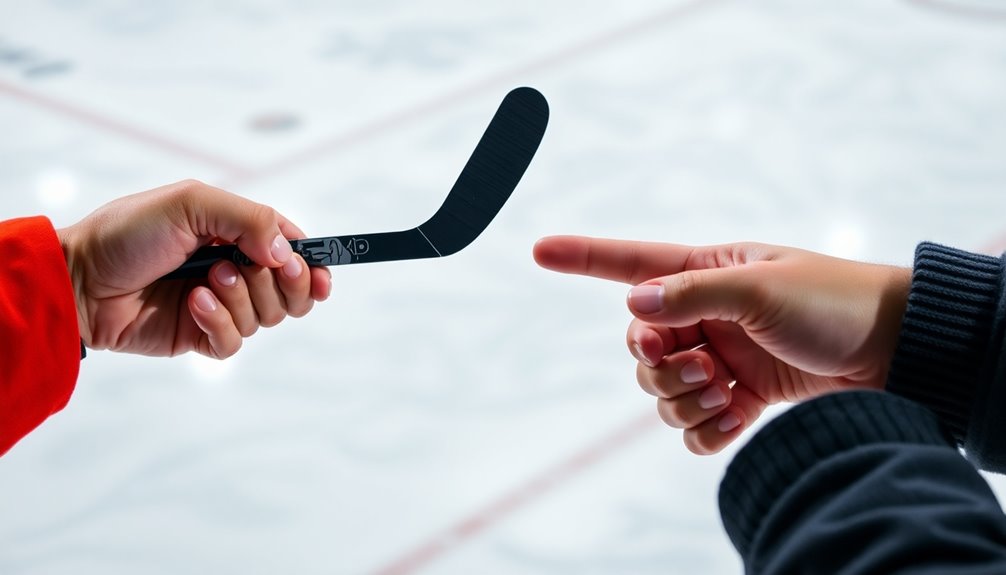
Wrist Shot vs. Snap Shot: Which Technique Is Best for You?
December 31, 2024Choosing between a wrist shot and a snap shot depends on your playing style and the game situation. The wrist shot offers superior accuracy and control, making it ideal for longer-range attempts. In contrast, the snap shot provides a quick release, perfect for tight spaces and fast responses. Think about your positioning on the ice and the pressure you face. You might find that mastering both techniques gives you the versatility to adapt to different scenarios. Understanding their mechanics and practical applications can enhance your shooting game, so let's explore how to refine these critical skills further.
Understanding Wrist Shots
When you step onto the ice with a puck, mastering the wrist shot can greatly elevate your game. This technique is all about maintaining contact between the puck and the blade throughout the execution, giving you greater control and accuracy.
To execute a wrist shot effectively, start by loading the puck on the heel of your stick. As you prepare to shoot, roll the puck toward the toe of your blade. This motion generates the power and precision you need. Additionally, ensuring that you have the proper field dimensions can help you understand spacing and positioning during gameplay. The concept of goal area is important for recognizing how to optimize your shooting angles.
A longer follow-through is essential for a successful wrist shot. It contributes to the drag required for stick flex, which enhances both shot speed and accuracy. This type of shot is particularly effective for set plays and longer-range opportunities, where hitting your target with precision is critical.
Mastering the wrist shot takes time and practice. Focus on perfecting the mechanics of loading, releasing, and following through to achieve ideal performance. Additionally, incorporating essential techniques for precision will further enhance your shooting skills.
Exploring Snap Shots
When you're ready to explore snap shots, you'll find they involve a quick tap of the puck followed by a sharp wrist movement, allowing for a speedy release. This technique shines in tight spaces, giving you the edge when there's no time for a full wind-up. Mastery of passing accuracy can greatly enhance your overall shooting technique, allowing for better execution in high-pressure situations. To achieve this, focus on team coordination as it enhances your ability to read the play and make quick decisions. Remember, teamwork is essential for success in any sport, helping you to create opportunities that a snap shot can capitalize on.
Snap Shot Technique Overview
The snap shot is a key technique in hockey that combines speed and power for an effective shot. To master the snap shot fundamentals, you'll want to focus on a quick tap of the puck followed by a downward snap of your wrist. This motion allows for a rapid release, resulting in increased shot power.
Puck positioning plays an essential role in executing a successful snap shot. You can position the puck at the heel, toe, or middle of the blade, giving you versatility in various situations. Keeping the puck tight to your blade minimizes drag, enabling you to get your shot off quickly, especially in tight spaces.
Timing is everything, and mastering your wrist movement is important for achieving both accuracy and speed. The snap shot's reduced wind-up compared to other shot types means you can capitalize on quick reaction opportunities, making it significant during gameplay.
Advantages in Gameplay
Mastering the snap shot greatly enhances your gameplay by providing advantages that can turn the tide in tight situations. This technique not only gives you a faster release than wrist shots but also allows you to surprise defenders and goalies alike.
Here are three key advantages of snap shots:
- Quick Execution: The minimal wind-up lets you release shots in tight spaces, making it harder for opponents to react in time.
- Efficient Power Generation: By utilizing stick flex effectively, snap shots deliver power quickly, creating scoring chances without lengthy follow-throughs.
- Versatility in Shot Selection: You can adapt your snap shot technique to different puck positions, enhancing your shot variation strategies based on game dynamics.
Moreover, focusing on snap shot training can improve your reaction time and overall offensive effectiveness.
By honing this skill, you increase your player adaptability, making you a more formidable opponent on the ice. Embracing the snap shot not only boosts your confidence but also elevates your game to a new level.
Key Advantages of Each Technique

When you compare wrist shots and snap shots, each technique has its own advantages that can enhance your game.
Wrist shots excel in accuracy and precision, making them perfect for those vital moments when you need to place the puck just right. Additionally, mastering soccer control move can significantly improve both shot techniques and overall performance on the ice. Regular practice of essential techniques is crucial for developing these skills effectively.
On the other hand, snap shots are all about speed and quick release, allowing you to respond rapidly in tight situations.
Accuracy and Precision
In the dynamic world of hockey, accuracy and precision play essential roles in scoring, and each shot technique brings unique advantages. Whether you're opting for a wrist shot or a snap shot, understanding the nuances of each can enhance your game. Here are three key points to take into account:
- Wrist Shot: This technique offers greater control and accuracy, making it perfect for long-distance shots. You can manipulate the puck's trajectory with your loading and follow-through, allowing for effective shot placement strategies.
- Snap Shot: Designed for a quick release, the snap shot helps you respond swiftly to game situations. Its mechanics—minimal drag and rapid wrist movement—enable you to maintain accuracy, even in tight spaces. This is essential when targeting zones that defenders overlook.
- Mastering Both: By honing both techniques, you can adapt to various game scenarios. This versatility maximizes your effectiveness in scoring opportunities, leveraging different puck control techniques based on the situation at hand.
Ultimately, whether you choose a wrist shot or snap shot, understanding their accuracy and precision will elevate your performance on the ice.
Speed and Quick Release
Understanding the speed and quick release of shot techniques can greatly impact your game. The snap shot stands out for its rapid execution, allowing you to take quick shots with minimal wind-up. This makes it ideal for sudden scoring opportunities, especially in fast-paced situations. By mastering quick release drills, you can enhance your ability to respond instantly when chances arise.
In contrast, while the wrist shot takes a bit longer due to its deliberate loading phase, it provides excellent control and accuracy. It's perfect for set plays where precision matters. However, if you're in a tight spot and need to react fast, the snap shot's mechanics—featuring a quick downward snap of the wrist—allow you to leverage stick flex for power without the need for extensive puck movement.
Moreover, the snap shot's versatility allows you to shoot from various puck positions—heel, toe, or middle of the blade. This flexibility is vital for effective shot selection strategies in dynamic game situations.
Balancing these techniques in your practice will guarantee you're ready for any scenario on the ice.
Situational Effectiveness
Each technique—wrist shot and snap shot—offers unique advantages depending on the game situation. Understanding these key differences can enhance your shot selection strategies and improve your overall performance on the ice.
- Wrist Shots: Ideal for long-range shots, wrist shots provide greater control and accuracy. Their extended loading phase is perfect for set plays, allowing for precision targeting.
- Snap Shots: In tight spaces, snap shots shine. Their faster release time lets you seize quick opportunities, catching defenders off guard and responding to game dynamics swiftly.
- Situational Awareness: Mastering both techniques means you can adapt your approach based on ice conditions and the defensive response you face.
Whether you need to take a calculated shot or react immediately, being versatile is essential.
Mastering Shot Mechanics
Mastering shot mechanics is essential for any hockey player looking to enhance their scoring ability. Understanding the nuances of shot variations like the wrist shot and snap shot can greatly improve your effectiveness on the ice.
To execute a wrist shot, start by loading the puck on the heel of your stick blade. Smoothly roll it to the toe as you shoot, which helps with control and accuracy. Prioritize a proper follow-through to maximize both power and precision. Incorporating cardio training into your routine can also improve your endurance, allowing you to maintain shooting effectiveness throughout the game. Additionally, focusing on cardiovascular endurance will help you sustain energy levels during intense gameplay.
In contrast, a snap shot demands a quick upward wrist movement followed by a swift snap to release the puck. Keep the puck close to the blade during the loading phase for an immediate shot.
In your practice drills, focus on these mechanics through technique comparisons. You might set up targets to refine your wrist shot accuracy or use a timer to improve your snap shot speed. Incorporating high-intensity interval training (HIIT) can enhance your overall shooting performance by improving your cardiovascular endurance, which is crucial for maintaining energy during games.
Repeating these drills will help you develop muscle memory, making each shot second nature. By mastering these shot mechanics, you'll be well on your way to becoming a more versatile and effective scorer.
Practical Gameplay Applications

Here's the revised content with the additional sentence included:
Having a solid grasp of shot mechanics sets the foundation for effectively applying these techniques during gameplay. Understanding when to use a wrist shot or a snap shot can greatly impact your success on the ice.
Here are three key practical applications to keep in mind:
- Game Strategies: Use wrist shots for long-range attempts where accuracy is essential. In contrast, snap shots are perfect for quick plays in tight spaces, allowing for a faster release. Speed training can also enhance your ability to execute these shots under pressure. Additionally, utilizing advanced composite materials in your equipment can improve your overall shooting performance.
- Player Positioning: Assess your surroundings. If you're cradling the puck, a wrist shot provides control for precision. If you're receiving a pass, opt for a snap shot to capitalize on immediate scoring opportunities.
- Shooting Drills: Incorporate both shot types in your practice routines. This not only hones your skills but also improves your adaptability during games, preparing you to face varying ice conditions and defensive setups. Additionally, continuous learning enhances your contributions to team success and personal growth.
Choosing the Right Technique
Choosing the right shot technique can considerably influence your performance on the ice. When deciding between a wrist shot and a snap shot, think about your game scenario analysis. For set plays or long-range shots, a wrist shot is your best bet. It allows for greater accuracy, especially when you move the puck from heel to toe.
However, if you find yourself in tight spaces or need to react quickly, the snap shot shines with its quick release, catching defenders off guard.
Evaluate your player positioning techniques and assess where you're on the ice. The puck's placement can determine which shot to use effectively.
Practicing both techniques will enhance your shot selection strategies, giving you the versatility to adapt to various situations during a game.
Conclusion
Ultimately, whether you prefer the finesse of a wrist shot or the quick release of a snap shot, each technique has its place on the ice. You might think the wrist shot's power is unmatched, but imagine the thrill of catching your opponent off-guard with a perfectly timed snap shot, zipping past their goalie. Embrace both methods to elevate your game and keep your competition guessing. The right shot can make all the difference in securing that winning goal!


